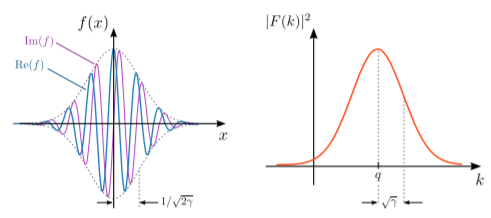10.6: Common Fourier Transforms
( \newcommand{\kernel}{\mathrm{null}\,}\)
To accumulate more intuition about Fourier transforms, let us examine the Fourier transforms of some interesting functions. We will just state the results; the calculations are left as exercises.
Damped waves
We saw in Section 10.2 that an exponentially decay function with decay constant η∈R+ has the following Fourier transform: f(x)={e−ηx,x≥00,x<0,FT⟶F(k)=−ik−iη.
Next, consider a decaying wave with wave-number q∈R and decay constant η∈R+. The Fourier transform is a function with a simple pole at q+iη: f(x)={ei(q+iη)x,x≥00,x<0.FT⟶F(k)=−ik−(q+iη).
On the other hand, consider a wave that grows exponentially with x for x<0, and is zero for x>0. The Fourier transform is a function with a simple pole in the lower half-plane: f(x)={0,x≥0ei(q−iη)x,x<0.FT⟶F(k)=ik−(q−iη).
Gaussian wave-packets
Consider a function with a decay envelope given by a Gaussian function: f(x)=eiqxe−γx2,whereq∈C,γ∈R.
We will show that f(x) has the following Fourier transform: F(k)=√πγe−(k−q)24γ.
To derive this result, we perform the Fourier integral as follows: F(k)=∫∞−∞dxe−ikxf(x)=∫∞−∞dxexp{−i(k−q)x−γx2}.
The Fourier spectrum, |F(k)|2, is a Gaussian function with standard deviation Δk=1√2(1/2γ)=√γ.

Once again, the Fourier spectrum is peaked at a value of k corresponding to the wave-number of the underlying sinusoidal wave in f(x), and a stronger (weaker) decay in f(x) leads to a broader (narrower) Fourier spectrum. These features can be observed in the plot above.


